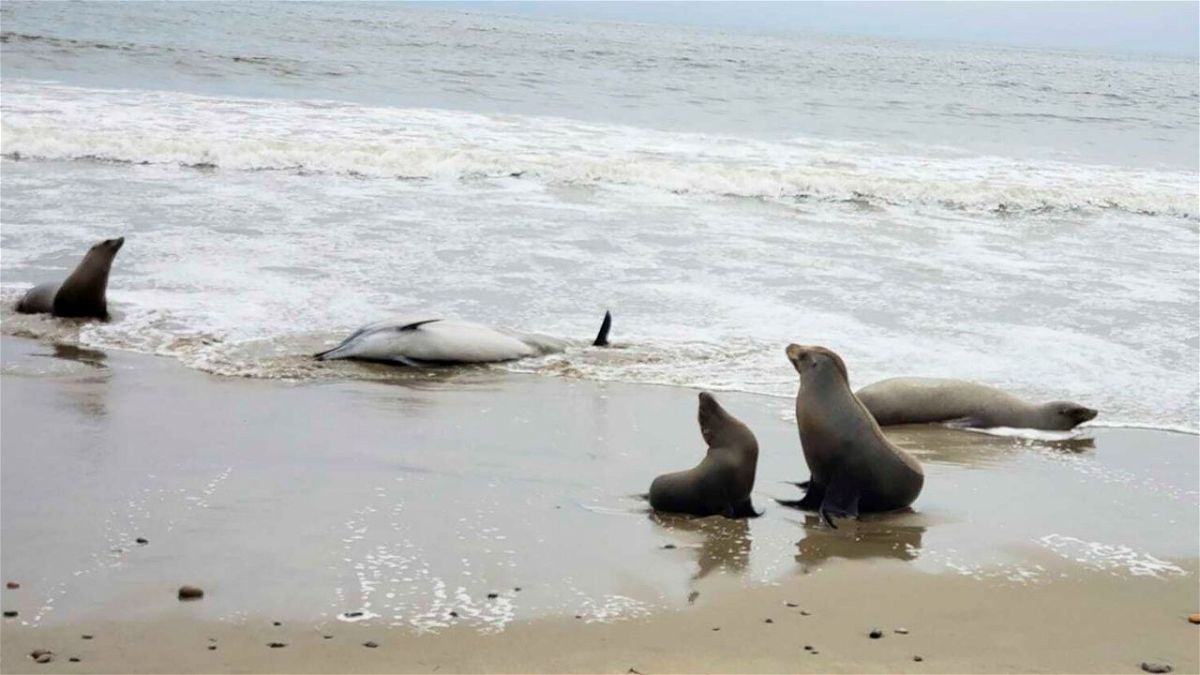Hundreds of dolphins and sea lions have washed up dead or sick in California amid toxic algae outbreak

Originally Published: 22 JUN 23 17:18 ET
By Rachel Ramirez, CNN
(CNN) — The scene is unsettling: hundreds of sea lions and dolphins are sprawled across the beaches in Southern California, either dead or sick and exhibiting abnormal behavior.
Officials have received more than 1,000 calls in recent weeks from beachgoers, tourists and residents reporting sick, dying and dead sea mammals washed ashore from Santa Barbara to San Diego County, amid a growing toxic algal bloom in the waters off the coast.
The wave of dead or sick animals is “one of the largest in memory,” Justin Greenman, a stranding coordinator with NOAA Fisheries, told CNN. “It’s completely overwhelming.”
And, Greenman said, it doesn’t appear to be ending any time soon.
Marine-life experts believe the harmful algal bloom is to blame, though they are waiting on test results to confirm it. The algae, Pseudo-nitzschia, produces a neurotoxin called domoic acid, which can be poisonous to seabirds and fish once ingested. It can then travel across the food chain to larger marine animals like dolphins, sea lions and even humans.
Like dolphins and sea lions, humans can get sick from domoic acid if they eat contaminated food, although seafood is tested for this toxin to prevent it from reaching dinner tables. The California Department Of Health specifically warned against eating “sport-harvested mussels, clams or scallops from Santa Barbara County” after high-levels of the toxin were detected there.
Ruth Dover, a co-founder and managing director of Channel Islands Marine and Wildlife Institute, which has been fielding hundreds of calls about the strandings, said they have responded to more than 100 dead sea lions and 300 live sea lions exhibiting signs of ingesting domoic acid in Santa Barbara and Ventura counties.
The death toll for dolphins is now up to 100, the group said, which Greenman describes as unusual – particularly in how this bloom appears to be affecting species that typically dwell far from the shore.
“It’s like the waves of a tsunami keep washing over our local beaches with even more sea lions and dolphins suffering from domoic acid,” Dover told CNN. “We thought last year’s domoic acid event affecting Santa Barbara and Ventura was tragic, but this year’s event is even more horrific.”
“Our beautiful beaches are littered with sick, dying and deceased sea lions and dolphins,” she said.
Tissue samples have been taken for testing to confirm that the domoic acid-producing algae is behind the crisis. But Michael Milstein a spokesperson for NOAA Fisheries, told CNN that the situation has “all the hallmarks of an algal bloom.”
Some harmful algal blooms thrive in warm water – making them more of a concern as ocean temperatures climb. But in other cases, like the ongoing bloom in California, it is driven less by water temperatures and more by strong coastal upwelling, which provides more nutrients that feed the algae.
“The water in that area is not especially warm right now, as it was during a similar event last year,” Milstein said. “That does not necessarily mean there is no climate connection, because there remains some possibility that climate change may favor more toxic algae, or influence ocean chemistry in ways that favor domoic acid production.”
This type of phytoplankton can bloom fast when there are changes to the amount of light and nutrients available. Harmful algal blooms in Southern California have happened in the past, but experts say they have increased in frequency and severity in recent decades, noting that a warming planet may play a role in this.
“It’s just scary, because you normally see the ocean as this source of life, and the idea that we have a poisonous ocean as a result of climate change and human activity is just devastating,” Geoff Shester, California director and senior scientist with Oceana told CNN. “We can warn consumers, but there is no warning that’s going to tell the dolphins and sea lions to avoid these fish.”
Rescuers are ‘physically tired and emotionally drained’
The California algal bloom began late in May. But on June 8, Dover said the group started getting calls, online reports, emails and texts “at an overwhelming rate.”
At some points, they were receiving up to 60 reports an hour of marine mammals in distress. That’s more than 300 reports in a day, and a gargantuan task for a small, nonprofit organization made mostly of volunteers.
“It is impossible for our small nonprofit organization to handle this unprecedented volume,” Dover said. “There are cases we cannot get to and it’s not because we don’t care. It’s because there are too many animals stranding with domoic acid for us to physically respond to in a day.”
When stranding reports come in, they dispatch the next available volunteer to drive to the site, walk the beach, find the animal and conduct a physical assessment, which includes photo and video documentation and recording exact geolocation as well as tide and beach conditions.
Carrying and transporting the animals that are still alive is another physical struggle that requires up to six volunteers, depending on the animal’s size, as well as some equipment and gear, according to Dover. Once they’ve been transported, the rescued animals receive immediate treatment, which includes intense hydration to flush the toxin out of their systems, anti-seizure medication and feeding them with fish that does not contain domoic acid.
“Our team members are physically tired and emotionally drained,” Dover said. “It is really difficult to watch an animal suffering from domoic acid, and we want to help each and every one of them.”
Mortality rates with adult sea lions have been significant, Dover said. And despite their treatment, many are dying either at the beach or even during transport to their facility for care. The mammals are experiencing multiple grand mal seizures and brain damage from the toxin, she said.
Dover said while they are still rescuing adult sea lions, they are trying to focus their limited manpower on rescuing young animals that may have ingested less of the toxin-laced fish.
Beyond Santa Barbara and Ventura counties, NOAA’s Greenman said the impacts of the algae are expanding to Los Angeles, Orange and San Diego counties. Dover’s group is just one of the many organizations that is a member of the Marine Mammal Health and Stranding Response Network, which is overseen by NOAA’s National Marine Fisheries.
“[The groups] do receive some federal funding, but that’s really a small drop in the bucket,” Greenman said. “But we’ve got a lot of people who’ve devoted so much of their time and their hearts, and it’s started to take its toll.”
The-CNN-Wire
™ & © 2023 Cable News Network, Inc., a Warner Bros. Discovery Company. All rights reserved.

